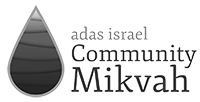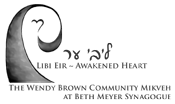Member Spotlight: Louisiana Community Mikveh
by Sarah Panzer, Rising Tide Intern
The Louisiana Community Mikveh is an open mikveh project fifteen years in the making, one that is deeply intertwined with the history of New Orleans.
 Before Hurricane Katrina, Congregation Beth Israel housed the largest mikveh in New Orleans. This Orthodox Congregation opened their mikveh to members of the surrounding Reform and Conservative Jewish communities to use. When Congregation Beth Israel was devastated by Hurricane Katrina in 2005, the New Orleans community was left without an accessible mikveh for years. Rabbi Bob Loewy, a founding member of the Louisiana Community Mikveh Project, recalls that members of the New Orleans community would have to travel to a mikveh in Houston to immerse, roughly five and a half hours away by car. Others resorted to using local public swimming pools and the lake at Henry S. Jacobs Summer Camp to immerse.
Before Hurricane Katrina, Congregation Beth Israel housed the largest mikveh in New Orleans. This Orthodox Congregation opened their mikveh to members of the surrounding Reform and Conservative Jewish communities to use. When Congregation Beth Israel was devastated by Hurricane Katrina in 2005, the New Orleans community was left without an accessible mikveh for years. Rabbi Bob Loewy, a founding member of the Louisiana Community Mikveh Project, recalls that members of the New Orleans community would have to travel to a mikveh in Houston to immerse, roughly five and a half hours away by car. Others resorted to using local public swimming pools and the lake at Henry S. Jacobs Summer Camp to immerse.
The New Orleans community was in need of a mikveh, one that was open and accessible to all. Rabbi Loewy shares that from its inception, the Louisiana Community Mikveh Project was created with the concept of a community mikveh in mind. The Rabbinic Council of Greater New Orleans began planning the mikveh in 2007, partnering with the local Jewish federation and the Oscar J. Tolmas Trust to plan and fund its cost. Since then, the Louisiana Community Mikveh has established a board of trustees consisting of a rabbi, lay representatives from nine congregations across Louisiana, an architect, and a contractor that continue to support its construction and development.
The Louisiana Community Mikveh is unique because of the complex and unfolding history of its community. The New Orleans Jewish community is small, close-knit, and incredibly active. This has created a culture of collaboration and communication between Chabad, Reform, Orthodox, and Conservative congregations in the area, all of which are enthusiastic about creative uses of the mikveh.
 Rabbi Loewy and Gail Chalew are also excited about the potential for the Louisiana Community Mikveh to provide a model for emerging mikva’ot in other small Jewish communities. This is where they believe that the Rising Tide Network may provide support, allowing leaders of the project to share their expertise and experience as a mikveh operating under a community model. The network has also provided access to guidelines from other established mikva’ot that are useful to shape the policies and guidelines of the Louisiana Community Mikveh. Importantly, Rabbi Loewy recalls that the last Rising Tide Gathering provided a valuable opportunity to meet with other leaders of established and emerging mikva’ot.
Rabbi Loewy and Gail Chalew are also excited about the potential for the Louisiana Community Mikveh to provide a model for emerging mikva’ot in other small Jewish communities. This is where they believe that the Rising Tide Network may provide support, allowing leaders of the project to share their expertise and experience as a mikveh operating under a community model. The network has also provided access to guidelines from other established mikva’ot that are useful to shape the policies and guidelines of the Louisiana Community Mikveh. Importantly, Rabbi Loewy recalls that the last Rising Tide Gathering provided a valuable opportunity to meet with other leaders of established and emerging mikva’ot.
Rabbi Loewy and Gail also hope that the story of the Louisiana Community Mikveh serves as a reminder that there are not only Jewish communities in the South, but that there are thriving Jewish communities in the South. New Orleans alone is home to about 12,000 Jewish community members from a multitude of denominational and cultural backgrounds. It is also home to several synagogues and the pluralistic Jewish Community Day School of Greater New Orleans. A Jewish New Orleans culture is deeply present in the city, and can be seen everywhere from kosher gumbo to Jewish Marching Krewes during carnival season. Of course, these are just a few examples of the rich southern Jewish culture in New Orleans.



